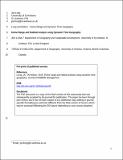Home range and habitat analysis using dynamic time geography
Abstract
Wildlife home ranges continue to be a common spatial unit for modeling animal habitat selection. Telemetry data are increasing in spatial and temporal detail and new methods are being developed to incorporate fine resolution data into home range delineation. We extended a previously developed home range estimation technique that incorporates theory from time geography, the potential path area (PPA) home range, to allow the home range to be defined at multiple spatial scales depending on the observed rate of movement within the data. The benefits of this approach are demonstrated with a simulation study, which uses multi-state correlated random walks to represent dynamic movement phases to compare the modified PPA home range technique with a suite of other home range estimation methods (PPA home range, kernel density estimation, Brownian bridges, and dynamic Brownian bridges). We used a case study on caribou (Rangifer tarandus) movement from northern Canada to highlight the value of this approach for characterizing habitat conditions associated with wildlife habitat analysis. We used a simple habitat covariate, percent forest cover, to explore the potential for misleading habitat estimates when home ranges do not include potentially visited locations (omission area) or include areas not possibly visited (commission area). We highlight the advantages of the dynamic PPA home range in the context of quantifying omission and commission areas in other home range techniques. Finally, we provide our R code for calculating dynamic PPA home range estimates.
Citation
Long , J & Nelson , T 2015 , ' Home range and habitat analysis using dynamic time geography ' , Journal of Wildlife Management , vol. 79 , no. 3 , pp. 481-490 . https://doi.org/10.1002/jwmg.845
Publication
Journal of Wildlife Management
Status
Peer reviewed
ISSN
0022-541XType
Journal article
Collections
Items in the St Andrews Research Repository are protected by copyright, with all rights reserved, unless otherwise indicated.

